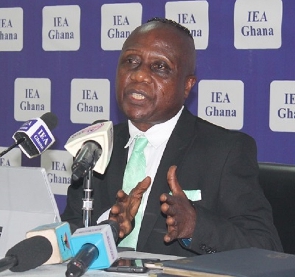 IEA Director of Research, Dr John Kwakye
IEA Director of Research, Dr John Kwakye
The Institute of Economic Affairs (IEA) Ghana has described the economic growth projections for Ghana under the US$3 billion Extended Credit Facility (ECF) programme of the International Monetary Fund (IMF) as “unambitiously low”.
Under the programme, Real Gross Domestic Product (GDP) is projected to grow at 1.5 per cent in 2023, 2.8 per cent in 2024, 4.7 per cent in 2025, 5.0 per cent in 2026 and 5.0 per cent in 2027.
Real GDP per capita is also projected to grow at negative 1.1 per cent in 2023, 0.2 per cent in 2024, 2.1 per cent in 2025, 2.3 per cent in 2026 and 2.4 per cent in 2027.
IEA-Ghana observed that the projections would take the country at least 20 years to double its real GDP per capita from the current US$2,500 to US$5,000.
“When are we then going to be able to close the gap with those who currently have real GDP per capita of US$30,000-50,000? We have abundant natural and human resources” the Director of Research at IEA, Dr John Kwakye, said at a press conference.
He said the economy could grow between seven to 10 per cent over the five-year period and double its real GDP per capita within 10 years instead of 20 years.
“We can scale up public and private investment. We can import additional capital and technology that we may lack through Foreign Direct Investment (FDI) and foreign labour,” he suggested.
Under the programme, inflation is projected to be 29.4 per cent in 2023 and 15.0 per cent in 2025 before reducing to the Central Bank target of 8.0 per cent in 2025, 2026, and 2027.
Dr Kwakye said the inflation projections were relatively high and could be reduced if the right instruments were used to measure and manage inflation.
He emphasised the need to supplement the demand-based Inflation Targeting framework with other measures that targeted the supply and cost drivers of inflation that included food prices, fuel prices, transport fares and depreciation.
“Our peers with the same economic structures as ours have been able to achieve lower rates of inflation using the appropriate demand and supply tools,” he said.
For the government’s revenue to GDP ratio, the IMF has projected an increase from 15.7 per cent in 2022 to 16.8 per cent in 2023, 17.3 per cent in 2024, 17.8 per cent in 2025 and 18.7 per cent in 2026 and 2027 respectively.
Though touted in the programme as a remarkable achievement, the IEA Ghana was of the view that the projections were mediocre as other middle-income peers have revenue to GDP ratio of 25-30 per cent.
The IEA called for more innovate taxes, leveraging technology to accelerate collections, capturing informal sector in the tax net, improving tax compliance and plugging loopholes such as trade mis-invoicing, unexploited property taxes, transfer pricing, money laundering, tax fraud and corruption.
“There is a huge low-hanging-fruit. We need to adopt more favourable fiscal regimes for the extractives sector,” he said.
Overall fiscal balance under the EFC programme is projected to decrease from negative 11.0 per cent in 2022 to negative 7.5 per cent in 2023, increase to negative 8.0 per cent in 2024 and then decline progressively to negative 6.7 per cent in 2025, negative 5.7 per cent in 2026 and negative 4.6 per cent in 2027.
At the same time, the primary balance is projected to decline from -3.6 per cent in 2022 to -3.1 per cent in 2023 and thereafter register positive balances of 0.5 per cent in 2024 and flatten at 1.5 per cent in 2025, 2026 and 2027.
The Director of Research observed that the fiscal balances showed an appropriately strong, front-loaded fiscal adjustment in 2023.
He said, however, the annual adjustments subsequently were moderate, “the reason it takes as far as 2027 to return the overall fiscal balance to within the ceiling of 5 per cent in the Fiscal Responsibility Act, which the Minister got Parliament to suspend in early 2020”.
“Precisely because of the unambitious fiscal adjustment under the programme, the projected public debt/GDP remains high.
“It rises from 88.1 per cent in 2022 to 98.1 per cent in 2023, which looks strange, given the strong fiscal adjustment in 2023 and thereafter declines gradually to 92.0 per cent in 2024, 90.2 per cent in 2025, 88.4 per cent in 2026 and 86.1 per cent in 2027,” he said.
He called for a stronger fiscal adjustment, entailing a strong revenue mobilisation drive combined with equally strong expenditure control and rationalisation effort.
Dr Kwakye noted that such an effort was needed to reduce debt significantly during the period while creating adequate space for under-funded development and social spending.